Biology - Gr.11 🧬 (UNIT 1: GENETICS) - Cell reproduction
1/85
Earn XP
Description and Tags
Name | Mastery | Learn | Test | Matching | Spaced |
|---|
No study sessions yet.
86 Terms
What is the cell theory?
1. The cell is the smallest living unit in all organisms
2. All living things are made of cells
3. All cells come from other pre-existing cells
What is the difference b/n prokaryotic and eukaryotic cells?
Prokaryotic:
simple & small
✅ cell membrane: cytoplasm, DNA/RNA, ribosomes
✘ membrane bound organelles: nucleus, nuclear membrane
ex. bacteria
Eukaryotic:
complex & large
DNA condensed inside the nuclear membrane
✅ membrane organelles: mitochondria, chloroplasts, lysosomes
ex. protists, plants, fungi
Prokaryotes have.../don't have...
✓ DNA
✓ Ribosomes
✓ Cell membrane
x nucleus
x Membrane bound organelles (mitochondria & chloroplasts)
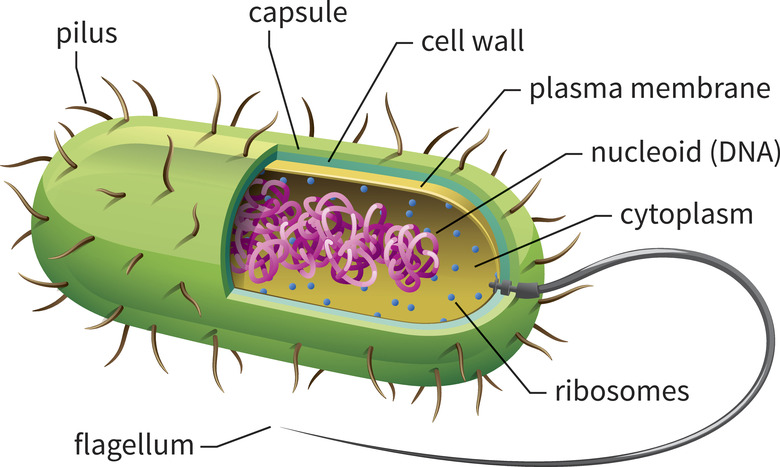
Eukaryotes have.../don't have...
✓ DNA
✓ Ribosomes
✓ Cell membrane
✓ nucleus
✓ Membrane bound organelles (mitochondria & chloroplasts)

Label this diagram (+ type of cell)
A: Nucleus
B: Nucleoplasm
C: Nucleolous
D: Nuclear membrane
E: RER
F: SER
G: Vacuoles
I: Chloroplast
J: Cell wall
K: Plasma membrane
L: Mitochondria
N: Golgi apparatus
M: Golgi vesicles
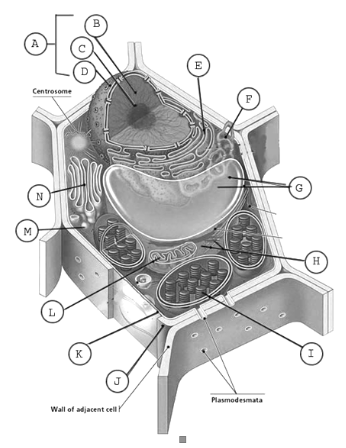
Nucleus
controls the cell (+ cell reproeduction & contains DNA)
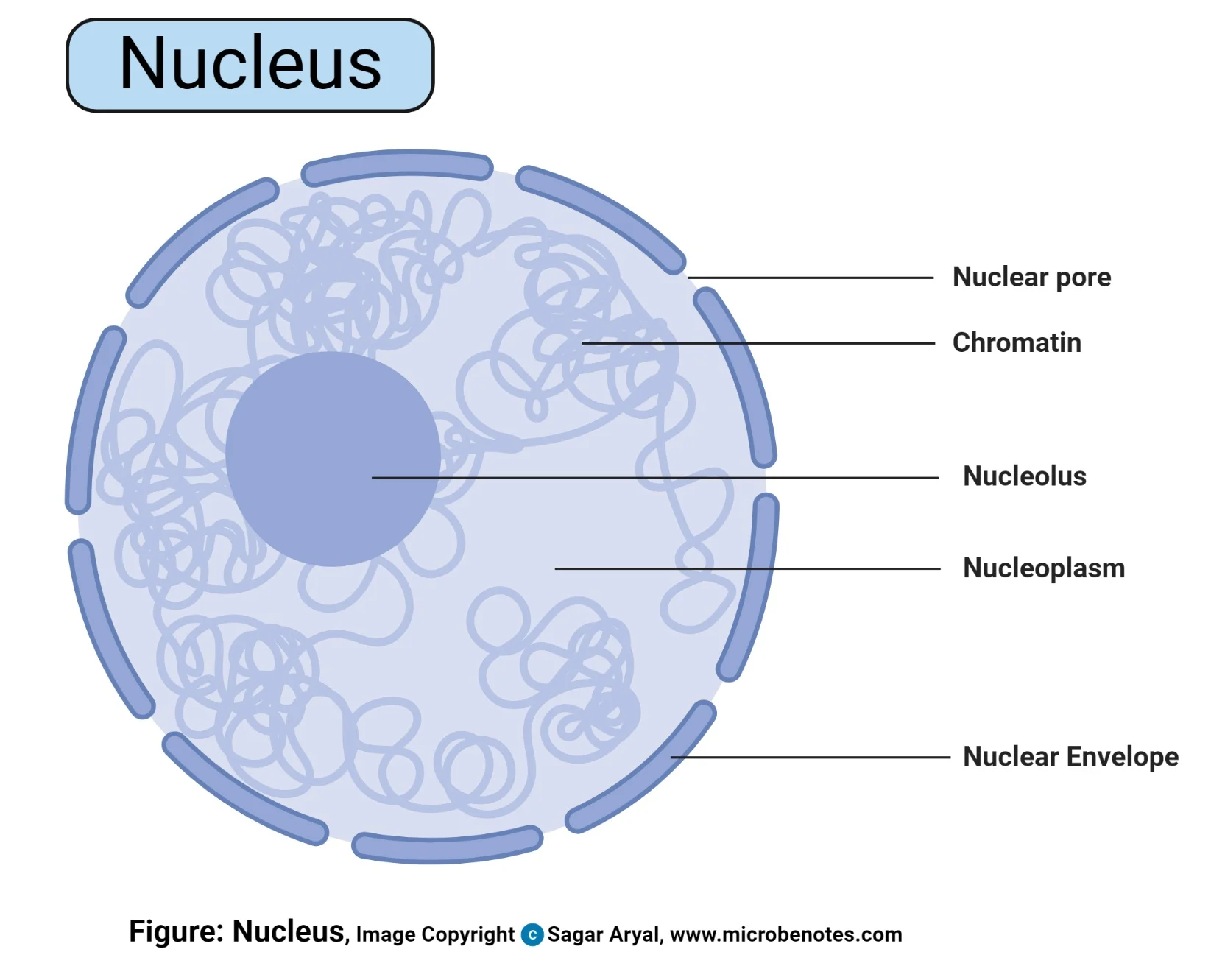
Nucleousplasm
where genetic info is found: several enzymes are present that help w/ synthesis of DNA and RNA (stores lipids and carbohydrates)
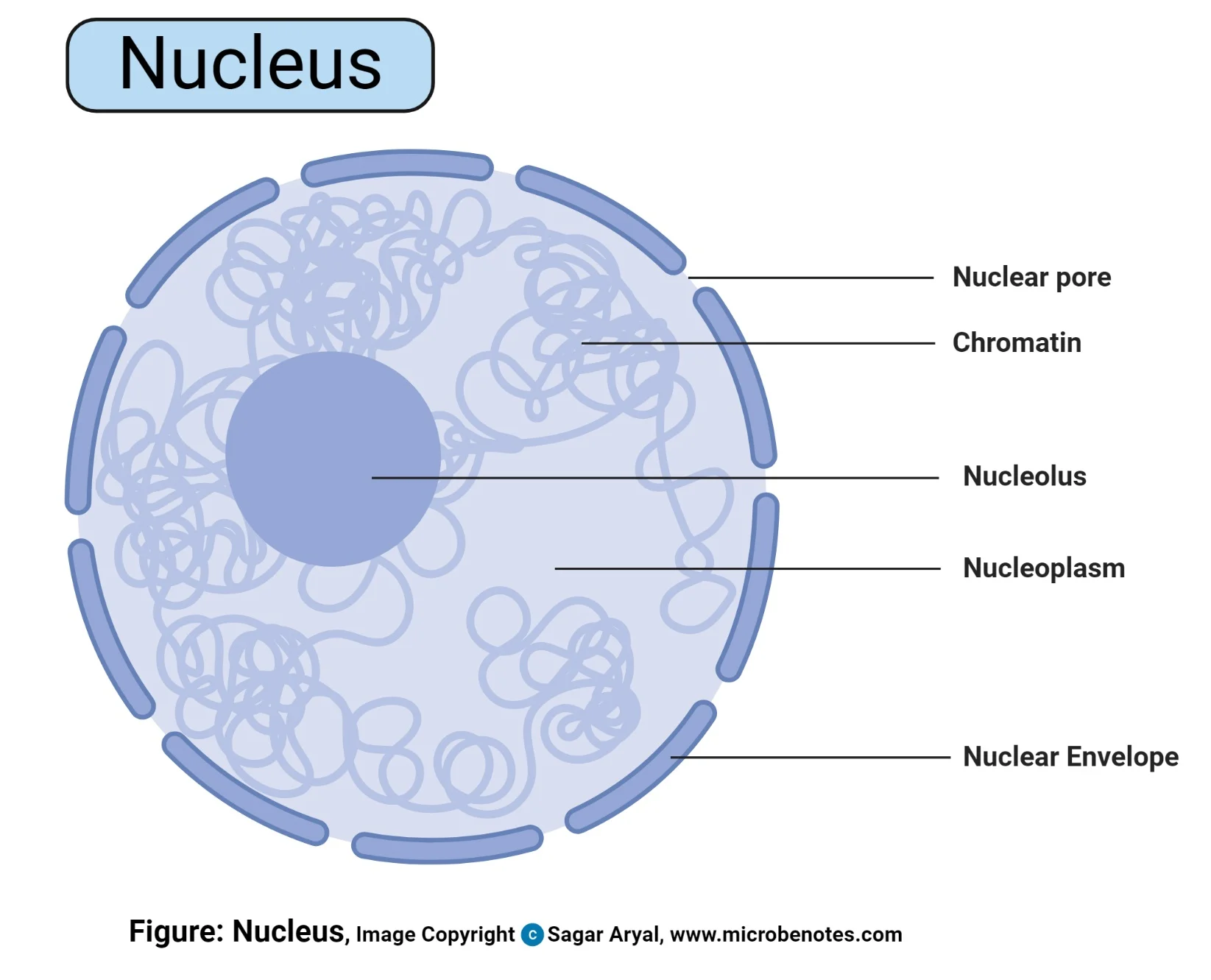
Nucleuolus
center of ribosomes synthesis and production of certain proteins
image: eukaryote

Nuclear membrane
double membrane that encloses the cell nucleus
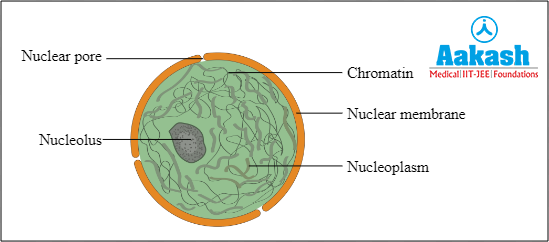
Rough endoplasmic reticulum (RER)
synthesizes and transports proteins. Rough = presence of ribosomes on the surface
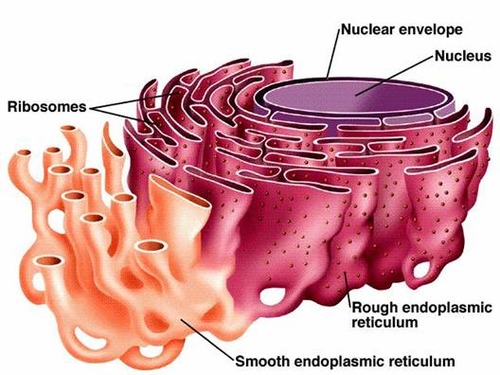
Smooth endoplasmic reticulum (SER)
metabolizes several chemicals and synthesizes lipids, phospolipids and steroids

Ribosomes
makes proteins

Vacuoles
LARGE in the plant cell, contains/stores water (maintains cell rigidity + acts like a storage)
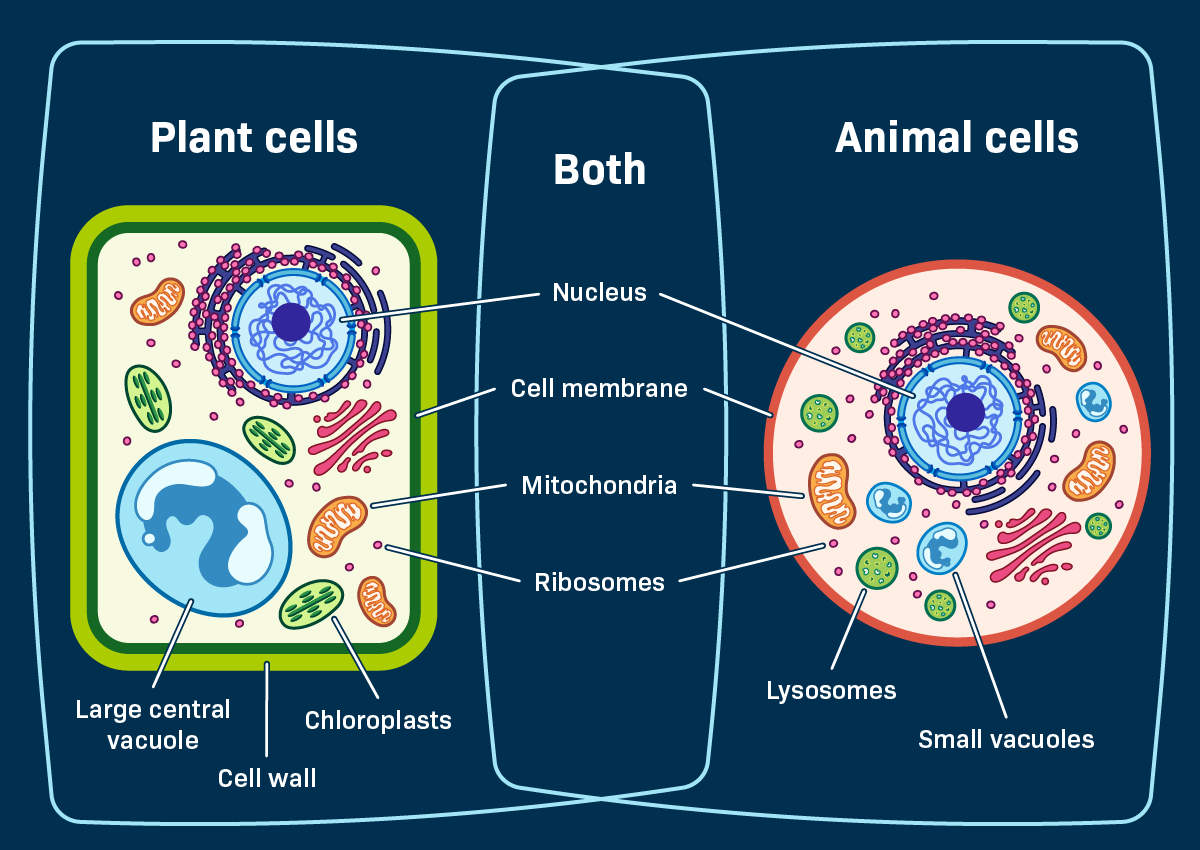
Chloroplast
performs photosynthesis (6CO2 + 6H2O → C6H12O6 + 6O2) in plant cells
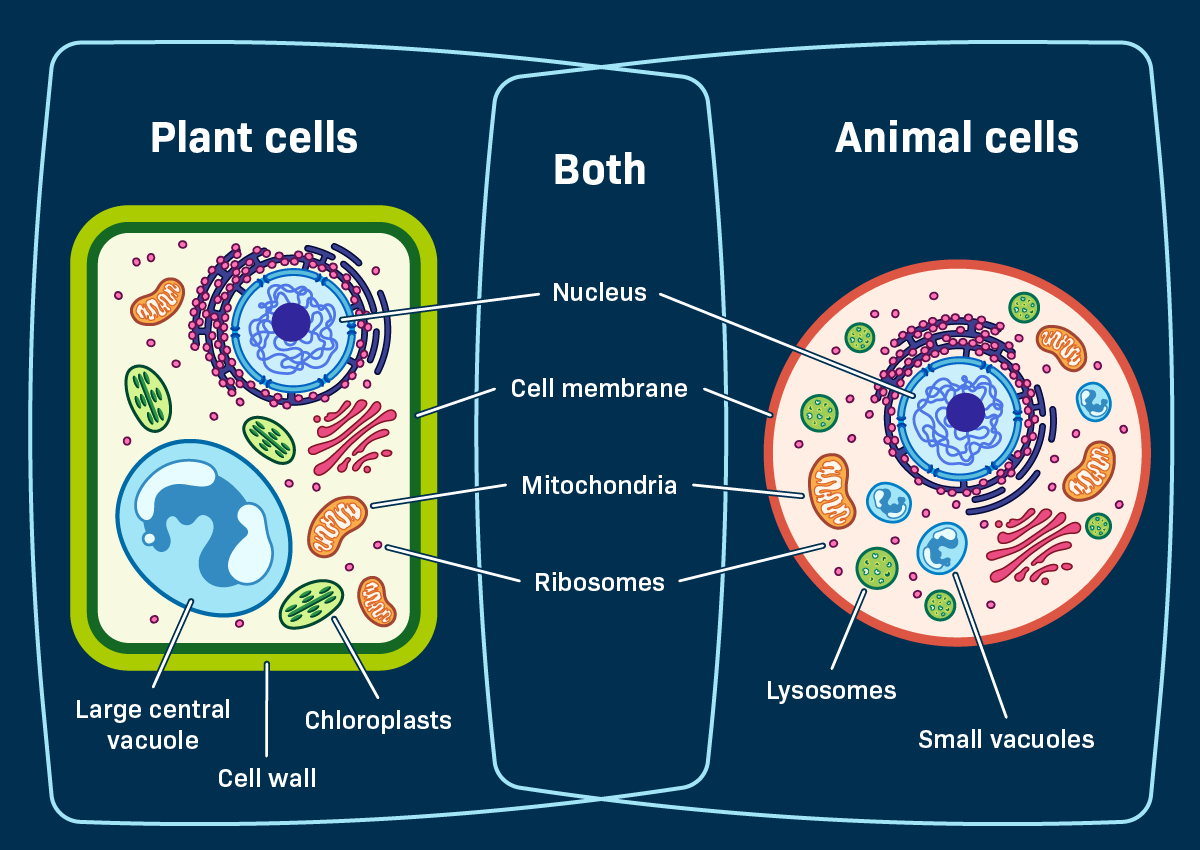
Cell wall
additional cell protection for plant cells (gives shape + protects from external forces)
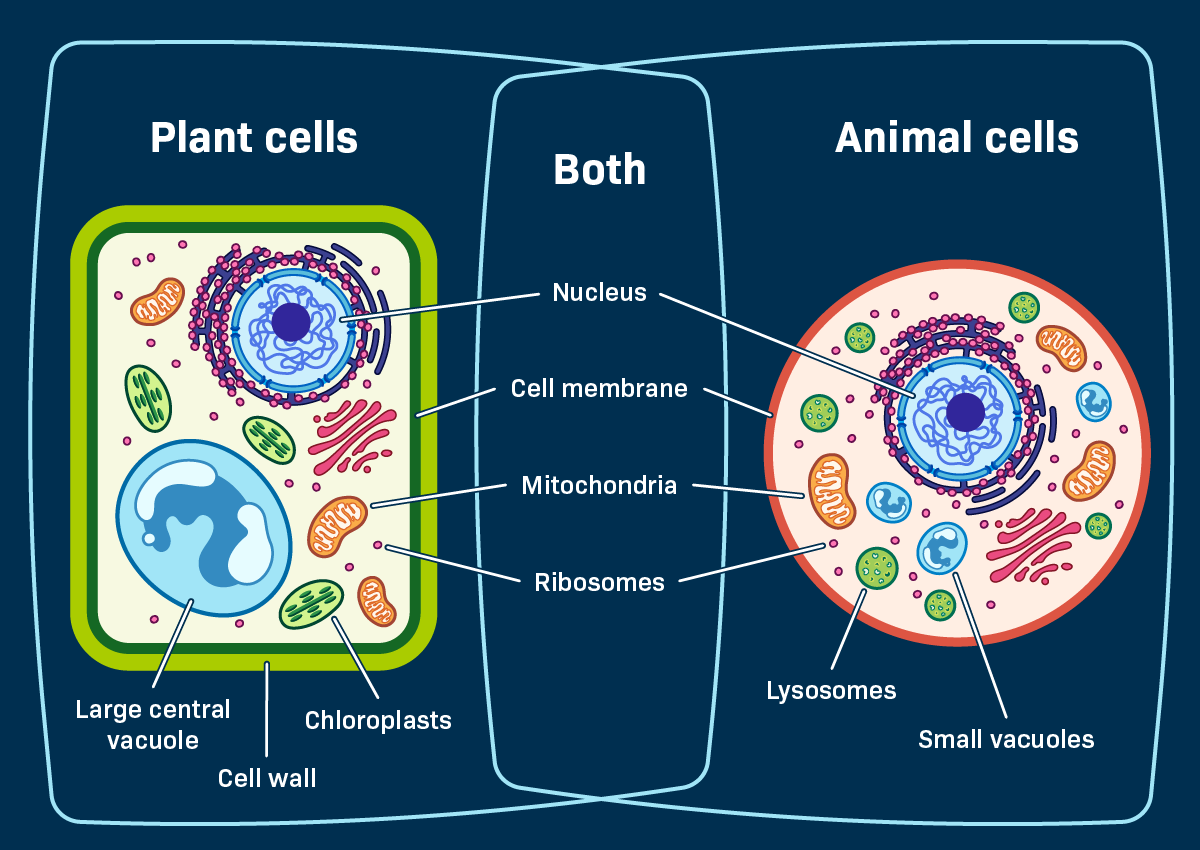
Mitochondria
performs cellular respiration (contains its own DNA)

Plasma membrane (aka cell membrane)
semi-permeable
controls what enters and leaves the cell (ex. complex proteins)
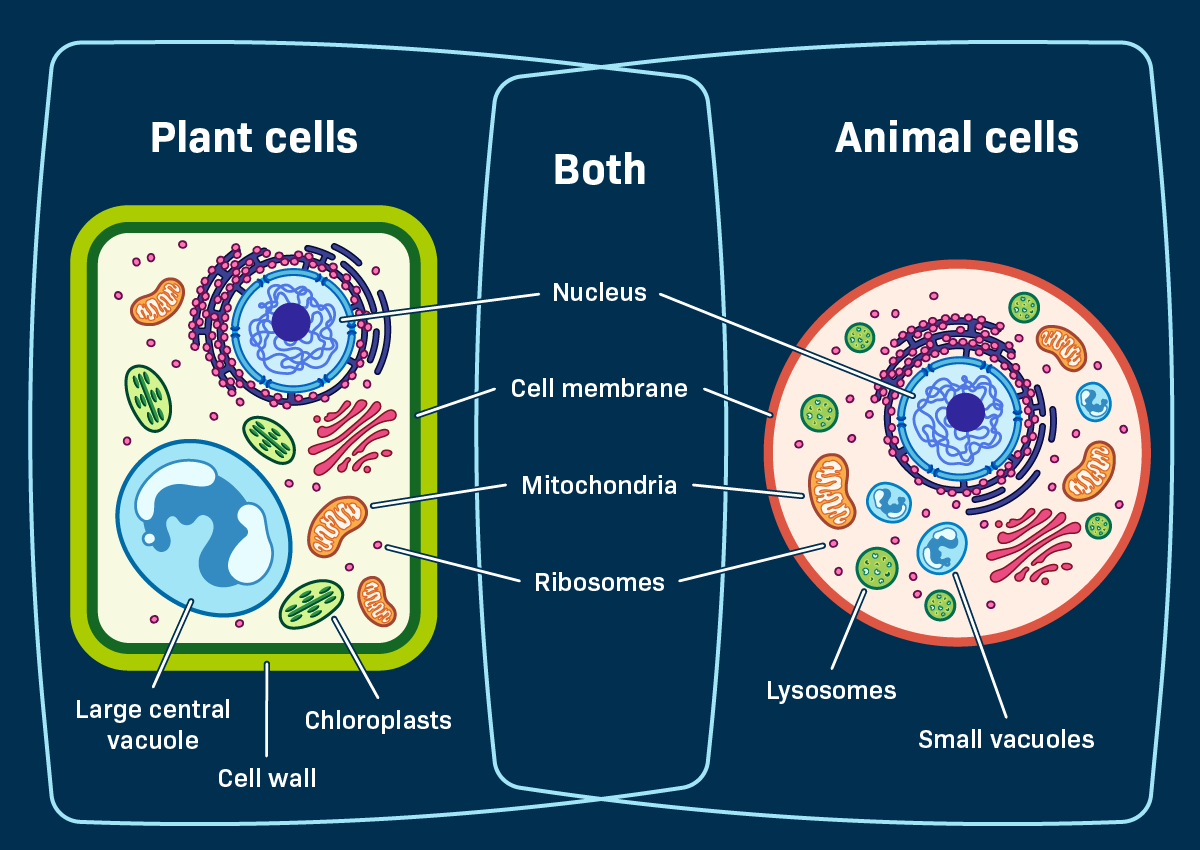
Cytoplasm
holds dissolved materials
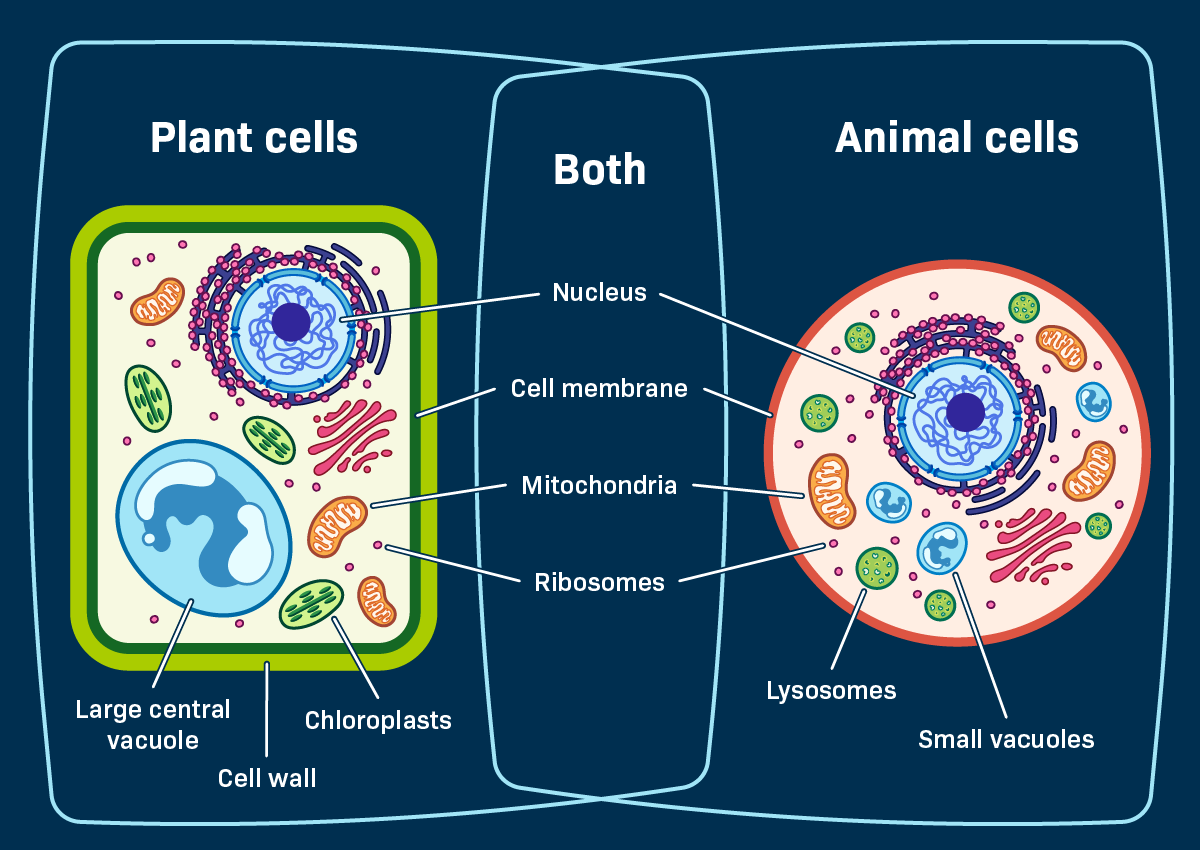
Golgi vesicles
transports molecules prodcued by other organelles
Golgi apparatus
stores and transports proteins and lipids
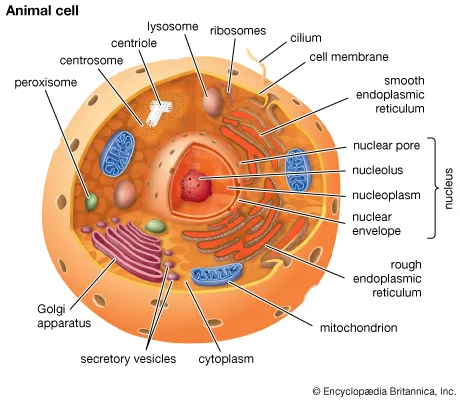
Lysosome
membrane-bound organelle that contains digestive enzymes

What’s the difference between animal and plant cells?
Animal:
no cell wall or chloroplast
presence of lysosomes
one or more small vacuoles
Plant:
has cell wall and chloroplast
no lysosomes
LARGE vacuole (bigger than nucleus)
What are the FOUR different forms of reproduction?
Budding
Vegetative reproduction
Parthenogenesis
Fragmentation
Budding:
formation of a new identical organism from a bud (ex. hydra)
Vegetative reproduction:
formation of a new plant (clone) from stolen (ex. strawberry), tuber (potato), rhizome (ex. in mint plant)
Parthonogensis
fertilization of an egg w/o the prescence of a male (sperm)
Fragmentation
Production of new individual when the parental organism divides into pieces (each piece produces a clone)
Binary Fission
→ bacteria and protists divide asexually by a process called ‘binary fission’ while eukaryotic cells use the process of mitosis
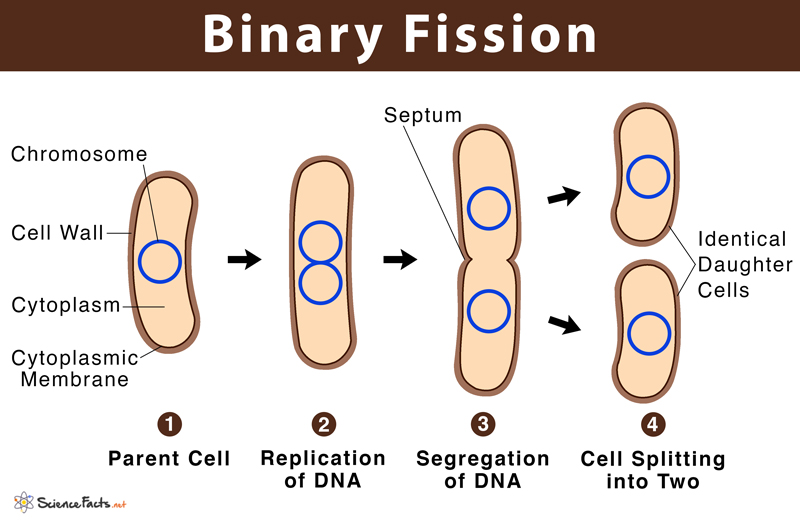
THREE reasons for cell division:
growth, repair, replace
Why do cells divide?
Cells need to divide because if they get bigger, they won’t be able to divide. Process of diffusion would be slower and the cell would not be able to get nutrients, remove waste and die.
The Cell cycle THREE stages:
1. Interphase
2. Mitosis
3. Cytokinesis
1. Interphase:
- most of the cell is interphase (90 %)
- chromosomes are copied (so each new cell has a full set of DNA)

Phase G1: (Growth)
First part of interphase
Cellular contents in the cell are duplicated
Phase S: (Synthesis)
DNA synthesis and replication (future cells obtain similar copies of DNA and associated proteins)
46 chromosomes are duplicated by the cell
Phase G2: (Growth + Preperation)
Replication or duplication of centrioles
Preparing for division
What is G0?
cell cycle arrest, which occurs if there’s an error
How many chromosomes do humans have?
46 chromosomes
2. Mitosis:
- purpose: separate replicated DNA into two identical cells
- 4 phases (PMAT)
- nucleus divides
Prophase:
- the double stranded chromosome becomes visible, the nuclear membrane disappears and spindle fibres form between the two poles of the cell & each centromere

Metaphase:
- the chromosomes move into an imaginary line across the centre of the cell

Anaphase:
- the centromere splits and sister chromatids separate which are now called 'daughter chromosomes'. They are now pulled to opposite sides of the cell

Telophase:
- one complete set of daughter chromosomes which unwind to form chromatin and the nuclear membrane appears

3. Cytokinesis
- In plant cells: golgi vesicles will fuse to form an equatorial plate which will fuse and separate the cell into two
- In animal cells: the "cell membrane" pinches off the centre (cleavage furrow)
- cytoplasm divides
- results in two daughter cells

Why is mitosis important?
Growth
Repair of damaged tissue
Regeneration (replacing dead cells)
In unicellular organisms (paramecia), mitotic division _______ the size of the population (reproduction)
INCREASES
In multicellular organisms the ____ and the _____ depends on mitotic cell division
GROWTH & REPAIR
How long does it take for skin cells to complete their processes?
14-20 days
How long does it take for brain cells?
20-50 years
What is cancer?
uncontrolled cell growth
Tumour:
a mass of cells that continue to grow and divide without any obvious function in the body
Metastatic cells:
cells that break away and start a tumour elsewhere in the body
Causes of cancer:
Mutations and Carcinogens
Mutations:
random changes in the DNA, results in the cell dividing uncontrollably
Carcinogens:
Environmental factors that can cause cancers (ex. tobacco smoke, radiation, UV rays)
Hallmarks of Cancer
Insensitivity to anti-growth signals
Evading the immune system
Genomic instability
Sustained angiogenesis
Tumour promoting inflammation
Give a desc of three hallmarks of cancer
Evading the immune system:
white blood cells are responsible for killing cancer cells, but cancer cells are able to hide. Similar to an ‘invisible cloak’. They can trick the white blood cells
Sustained angiogenesis:
tumour collecting blood flow (leading and causing growth). New blood cells are formed and allows the tumour to receive oxygen and nutrients
Genomic instability:
In heredity cancers, it’s mutations in the DNA which affects how certain cells divide
What’s the difference b/n somatic and cancer cells?
Cancer cells are uncontrolled cell growth and somatic cells are normal cells besides germ and sex cells. Cancer cells metastasize (travels to different parts, they CANNOT self-destruct (apoptosis)
What are three ways to treat cancer?
Chemotherapy
Radiation
Surgery
Ways to avoid having cancer:
- Lifestyle choices
- avoiding smoking
- eating healthy
- wearing sunscreen
What does the acronym DNA mean?
Deoxyribonucleic acid
What is the Hershey-Chase experiment?
Experiment description: Phage dyed w/ radioactive dye. DNA core and protein coat. One phage used sulfur for the protein coat and the other used phosphate (only found in DNA). Phosphate was able to enter the bacteria proving that…
→ genetic info is carried in DNA and NOT in proteins
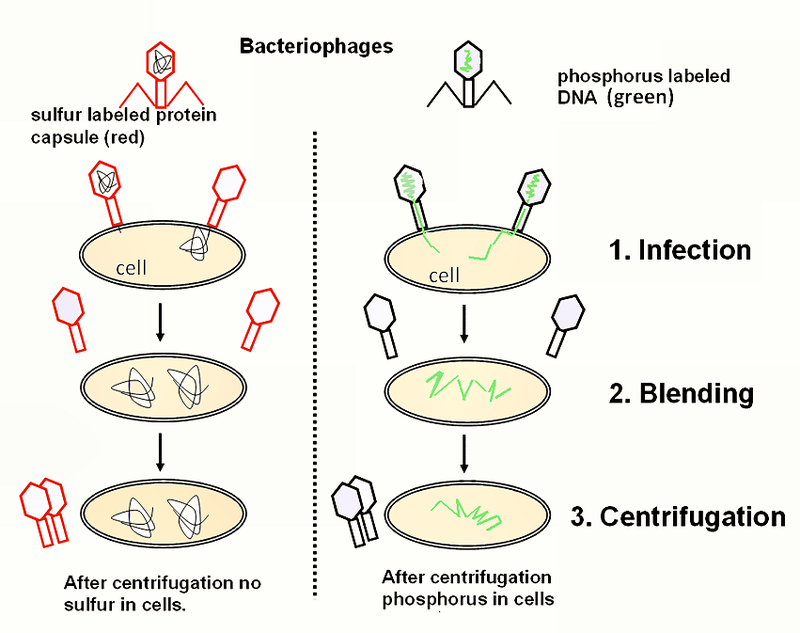
What are the THREE components of the structure of DNA (nucleotide)?
Sugar (deoxyribose-pentose) - pentose, shaped with five sides
Phosphate group
Nitrogenous base (4 different one)
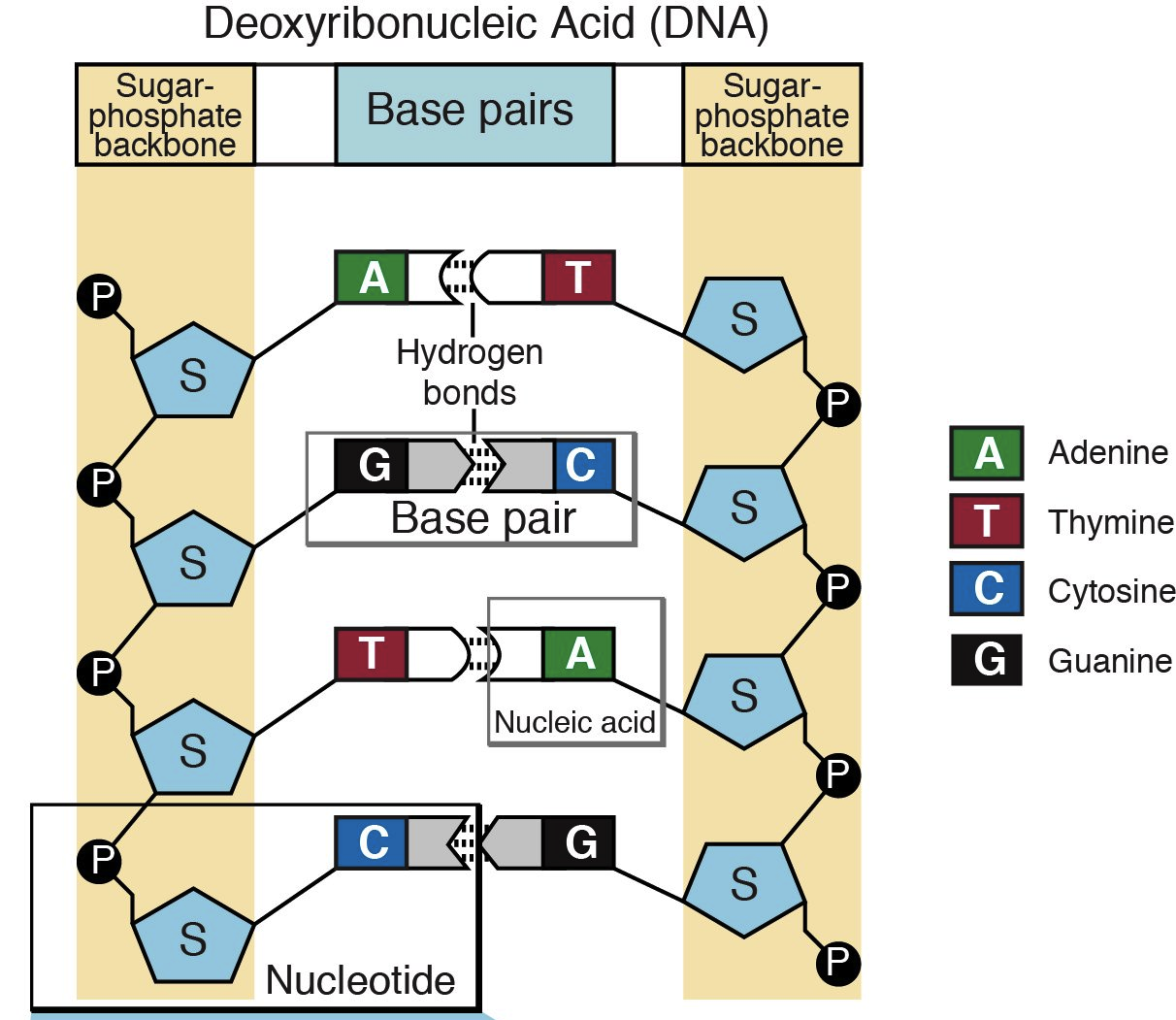
What are the FOUR nitrogenous bases? How many rings?
Purines (double ring):
Adenine (A)
Guanine (G)
Pyrimidines (single ring):
Thymine (T)
Cytosine (C)
What are the complementary bases?
A-T = 2 hydrogen bonds , C-G = 3 hydrogen bonds
What is Erwin Chargaff’s theory?
→ the amount of A&T were similar and true for C&G (ratios are equal)
→ 30% C-G
→ 70% A-T
What is Rosalind Franklin’s theory?
→ used x-ray crystallography to determine that the structure of DNA is in the form of a double helix (photo 51)
What is Watson & Crick’s theory?
→ used existing date (Franklin’s) to determine 2 strands lined up in opposite directions (double helix, backbone)
strand: formed from sugar, phosphates, nitrogenous bases. The bases are held by hydrogen bonds
What is meiosis?
→ production of sex cells (gametes) such as sperm and the ovum that are genetically different
→ Human somatic cells contain: 46 chromosomes
→ Gametes contain: 23 chromosomes
What’s the difference between Diploid vs Haploid?
Diploid: 2n
(2 sets of chromosomes, Mother & Father)
Haploid: n
(1 set of chromosomes, genetically different)
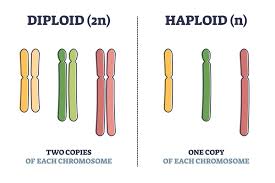
Each sperm cell and egg cell contains:
22 autosomes
1 sex chromosome (either X or Y)
What are the THREE purposes of Meiosis?
Reduction of # of chromosomes so that fertilization can regenerate the regular # of chromosomes
23 chromosomes from mother & 23 from father
Chromosomes that are similar in shape, length and arrangement of genes are called ‘homologous chromosomes’
PART 1 - Chromatin Replication (interphase ‘S’ phase)
producing an exact copy of all the chromatin in the original nucleus to produce enough chromatin for 4 copies ( 4 gametes)
PART 2 - Meiosis
chromatin copies are split twice and randomly distributed to form 4 completely different haploid nuclei
Prophase (l)
exchange of genetic material occurs between the maternal and paternal chromosomes (synapsis)
→ causing variation
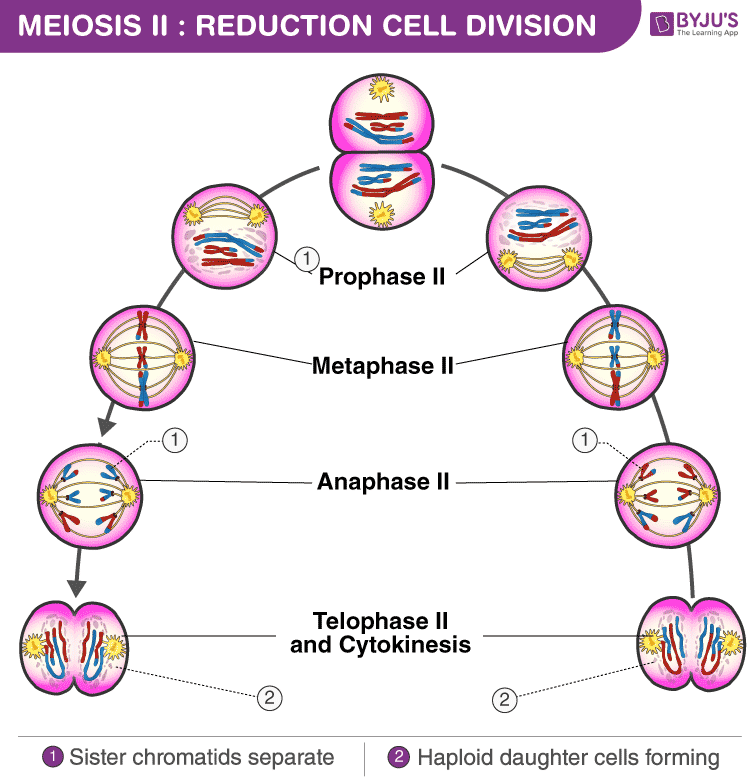
Metaphase (l)
the paternal and maternal chromosomes from the original nucleus are randomly distributed to form 2 new nuclei
the homologous pairs line up side by side in the middle of the cell
spindle fibers connect to the centromeres
they are called ‘tetrads’
→random assortment
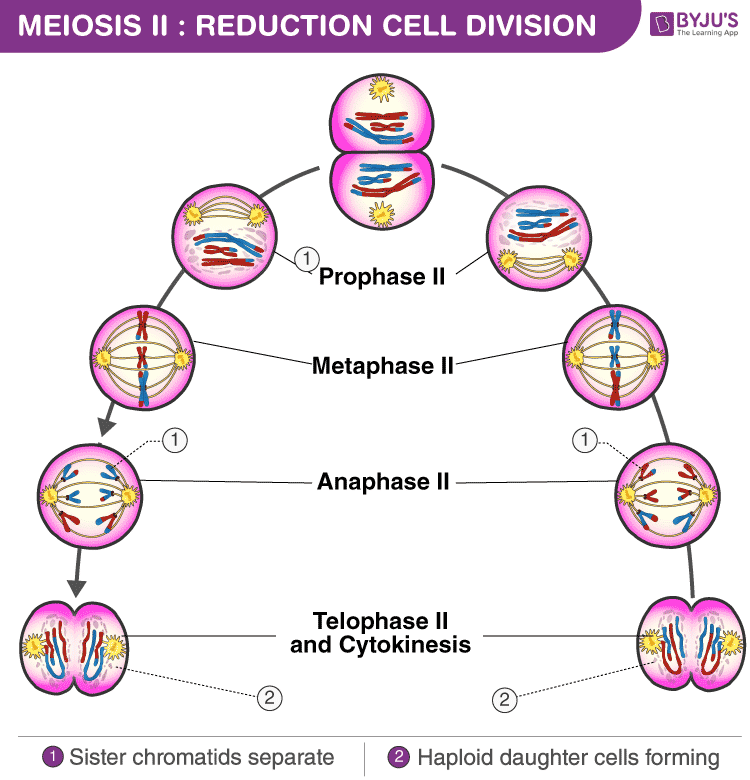
Anaphase (l)
homologous pairs are pulled to opposite poles of the cell

Telophase (l)
the chromosomes are at opposite sides and form two clusters
it will divide to develop two daughter cells (23 chromosomes in each)

Meiosis (ll)
Prophase (ll)
Metaphase (ll)
Anaphase (ll)
Telophase (ll)
*similar to mitosis
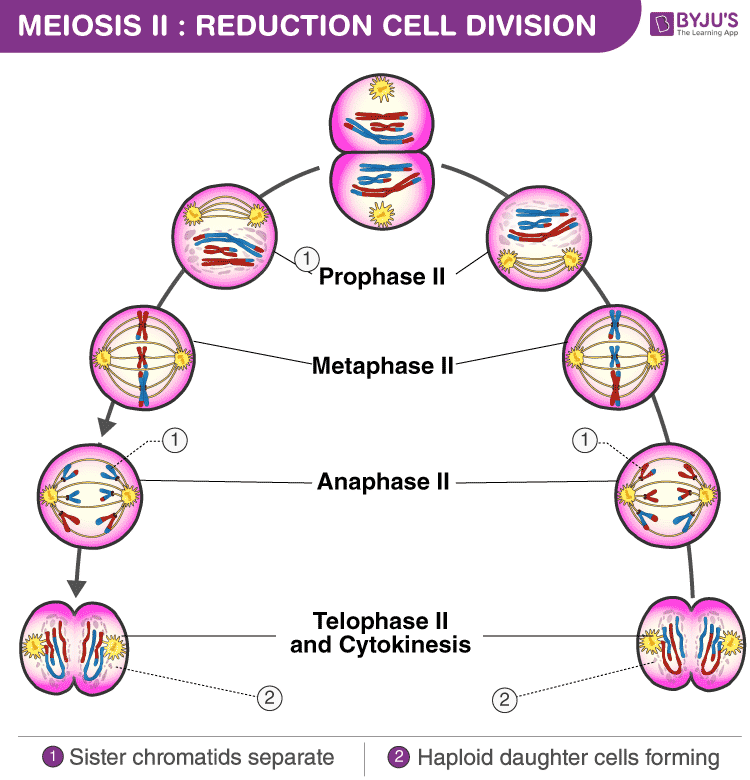
Part 3 - Cytokinesis
division of the cytoplasm into four parts (4 haploid cells)
If there’s there’s a set with 3 chromosomes, it’s called ____
a Triploid
THREE Examples of syndromes (can determine from karyotypes)
Turner syndrome (XO = monosomy)
Klinefelter’s (XXY = trisomy)
Super Female or Triple-X (XXX = trisomy)
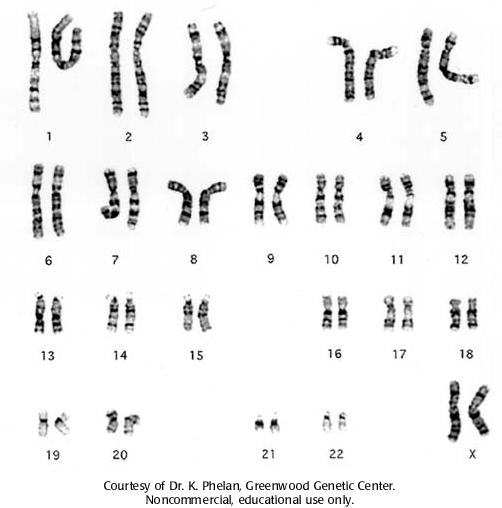
Two facts of spermatogenesis?
from spermatogonia, diploid stem cells (2n chromosomes), lead to spermatozoa, haploid male gametes (n chromosomes)
Spermatogenesis begins at puberty and reaches to around 20-30 yrs old
What are the THREE hormones that play an important role during spermatogenesis?
Testosterone
LH (Luteinizing hormone)
FSH (Follicle stimulating Hormone)
Facts about oogenesis?
Oogenesis takes place in the ovary
The egg undergoes “pre-meiosis”
→it stops at the diplotene stage of meiosis L, then it undergoes a small increase (cell volume increases).
Oocyte l takes place before birth
At puberty. this oocyte l will enter a phase of great (and rapid) growth, and finally the maturation phase
Maturation occurs thanks to meiosis (reductional). However, it will result in two cells of different sizes
Oocyte ll (vast majority of cytoplasm)
Polar body
What is ovulation?
release of the egg
Process of ovulation?
Ovulation takes place a few hours after this maturation
Oocyte ll has already initiated its second division of meiosis (equational), but will be blocked in metaphase ll
If oocyte is fertilized by a sperm, it completes its division and gives rise to an ovotid (ovum = haploid female gamete) and a second polar body